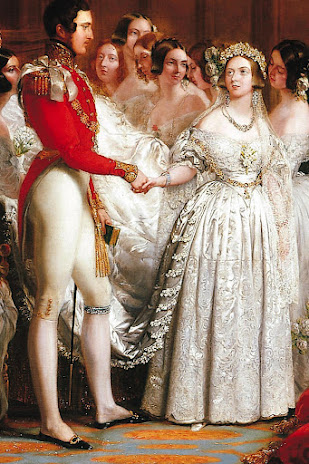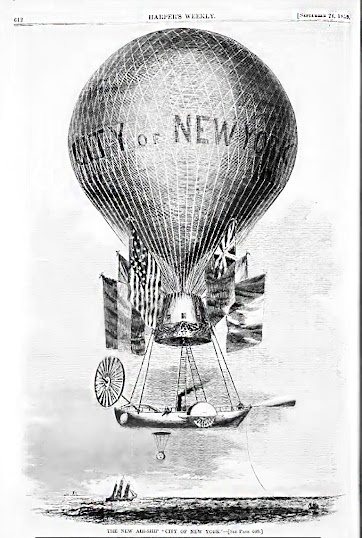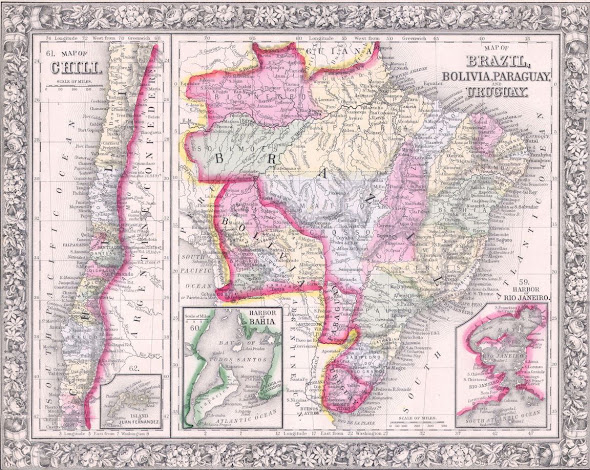William & Kate! Harry & Meghan! Charles & Diana! Vicky & Albert! Fred & Vicky! Bertie & Christian!
William & Kate!
Harry & Meghan! Charles & Diana! Vicky & Al! Fred &
Vicky! Bertie & Alexandra!
American newspapers and magazines have long devoted large
chunks of their publications to the adventurous and romantic goings on of the
British Royal family. It certainly didn’t start with William and Kate or
Charles and Diana.
A few weeks after her 18th birthday, Victoria
became queen of England in 1837, just at the dawn of mass media. After more
than a century of stodgy German kings, there was finally a beautiful young,
unmarried princess, one that fit the fairy tales. Her prince, literally, was Prince Albert, of
Saxe-Coburg-Gotha, one of the very numerous independent dukedoms,
principalities in the area known by the geographic catch-all
term, Germany. The couple was good
looking and in love. The young queen had
designed her own wedding dress adorned with yards of English lace, lace which
was removed revealing a simple all white dress before she went up the aisle to
the altar because she “wanted to marry her husband as a woman not as a
queen.” The American press went
wild. Among other things, it started the
fashion of brides wearing white.
It did not take long for the couple to start producing
princesses and princes at a rapid pace, eight in all.
Among the many royals followed by the American press, was Victoria, the eldest child, named for her mother and styled “The Princess Royal.” She was by all accounts the smartest and best informed of the royal brood. She spoke several languages fluently and developed a keen interest in politics from her father.
The official court painting of the the marriage of Frederick and Victoria
At age 17 on January 25, 1858, Victoria, the Princess Royal, was married to a handsome prince in yet another love match, crown prince Frederick of Prussia, heir to the throne of Prussia, then the largest of the many German petty states. The American press followed the event breathlessly for months from earliest speculation as to whom the Princess Royal would marry to her life in Berlin after the honeymoon.
Harper's Weekly January 1858
By anybody’s standards, the wedding was a fairy tale. For the bride, though, the planning was hell. The queen insisted on designing
her daughter’s gown and those of her bridesmaids while Prince Albert dickered
behind the scenes with the Prussian nobility for a larger royal allowance for
his daughter after the marriage. The
Queen absolutely insisted the marriage take place in London, not Berlin, even
though her daughter would be Queen of Prussia, and, later, Empress of Germany.
While Queen Victoria and her husband were German royalty
themselves—all the king George’s and William IV were also kings of Hannover, a
medium size kingdom in northwest Germany—the Prussians would have preferred the
crown prince had married the daughter of a Prussian nobility.

After the honeymoon, it was abundantly clear the new bride was not really welcome in Berlin. Her mother-in-law ignored her or tried to bully her. The Prussian crown would make no allowance for her expenses and gave her husband a pittance to live on. Albert and Queen Victoria were incensed and granted their daughter an income of 40,000 pounds a year. Frederick and Victoria lived on her money, not his.
Worse, the young couple held liberal views such as believing
in a constitutional monarchy!!! When a wave of antisemitism swept through
northern Germany, the crown prince and his wife showed up to attend services at
various synagogues around the kingdom to show support.
This was anathema to the Prussian nobility and particularly
to the Prussian chancellor Otto von Bismarck who ordered them surrounded with
spies. It was so bad that Frederick and Victoria smuggled private papers out of
Prussia to England when they returned for the funeral of Victoria’s father in
1862.
Like her mother, Victoria gave birth to eight children, the
first, a male heir, was Wilhelm. The birth
was a difficult one and as a result the boy was born with a withered left arm,
and, possibly, some mental deficiencies.
Victoria with her eldest son Wilhelm 1870s
Victoria’s younger brother, Bertie,
the Prince of Wales, married Princess Alexandra of Denmark in 1863. When Bismarck’s plotting started a war with Denmark in 1864, Fredrick's wife, Victoria, was smeared with the rumor she was a Danish sympathizer
since her brother, the Prince of Wales, had married a Danish princess.
After defeat of France in 1870 in the Franco-Prussian War, Bismarck forced all the minor German kingdoms and principalities to unite under Prussia to form modern Germany, known then as the German Empire.
Now the couple were not only in line to become King and Queen of Prussia but also Emperor and Empress of Germany. Their liberal politics did not abate and so Bismarck had their oldest son taken away and educated in the military and conservative politics.
Two of Victoria’s children died in childhood and neither Queen Victoria nor Victoria’s Prussian mother-in-law offered any sympathy. Only her husband, Frederick, also grieving, offered her any solace. Queen Victoria told her daughter that loss of a husband was far worse than loss of a child.
Frederick’s father, Wilhelm I, became deathly ill at about the same time as Frederick in 1888. Their son Wilhelm, his indoctrination into conservative politics and militarism was so complete he accused his mother of being glad her husband was dying.
The head of the German general staff so distrusted Frederick’s liberal politics that they planned a military, take over if he became Emperor. However, when his father died, Frederick was so ill himself he could barely speak. Doctors diagnosed his malady as terminal cancer of the larynx. The military decided Frederick could not last very long.
He
didn’t.
He was emperor Frederick III for 99 days. At his death, Victoria became dowager empress, known now as “the Empress Frederick.” Wilhelm moved her almost immediately out of the imperial palace. Her son would have preferred that she had left the country entirely, but she stayed in Germany. She built a small castle and estate to which she retired for the rest of her life.
Before her death, she had many of her private papers expressing concerns about Germany's fate under her erratic and headstrong son Wilhelm smuggled back to England by Edward VII's private secretary. Wilhelm would go on to end the German Empire less than 50 years after it began by plunging Germany into the First World War.
Victoria and her mother, Queen Victoria, exchanged almost 8,000 letters, nearly all of which survive. Many detail the inner workings of the Imperial German court.
Victoria died of breast cancer August 5,1901, surviving her mother, Queen Victoria, by less than seven months. She was buried with her two young sons and her husband in Potsdam near Berlin.



















Comments
Post a Comment